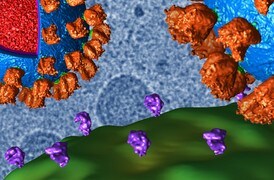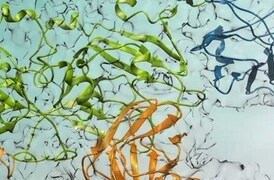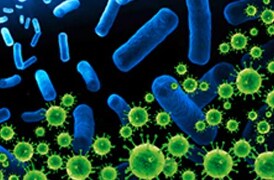Search Thermo Fisher Scientific
- Contact Us
- Quick Order
-
Don't have an account ? Create Account
Search Thermo Fisher Scientific
Available on Thermo Scientific Krios and Glacios Cryo-TEMs, the Thermo Scientific Selectris and Selectris X Imaging Filters are post-column imaging filters that improve the contrast of TEM images, resulting in high-resolution structures up to atomic resolution. The zero-loss filtering of the Selectris Filters removes noise caused by inelastically scattered electrons, producing an increased signal-to-noise ratio (SNR) and better contrast. Designed for high stability, the zero-loss peak position of the Selectris Filters has minimized sensitivity to temperature variations in the environment, eliminating the need for frequent tuning.
With the Selectris Filters, zero-loss energy filtering is straightforward due to the thorough integration of software and hardware along with extensive automation and exceptional stability. Every mechanical and electron-optical element has been designed for stability and data reproducibility, enabling the unattended and reliable acquisition of large datasets with narrow energy slit widths (<10 eV). The capability to use these narrow slit widths provides an additional boost in contrast for single particle cryo-electron microscopy (cryo-EM), enhancing signal strength, resolution, and throughput.
Paired with the latest generation Thermo Scientific Falcon 4i Direct Electron Detector, Selectris Filters allow you to obtain high-resolution structures quickly, revealing new biological insights. Incorporated Falcon 4i camera with electron event representation (EER) enables efficient file size compression, super-resolution capabilities and maximized sensitivity for all use cases. To further increase the productivity and ease-of-use of your cryo-EM workflows for single particle analysis and cryo-electron tomography, these filters are fully integrated into Thermo Scientific EPU Software, Thermo Scientific Tomography Software, and our instrument operation software.
The Selectris X was designed for researchers seeking industry-leading optical performance, while the Selectris is ideal for those who require maximum efficiency and throughput. Expanding on the stability, ease-of-use, and performance of the Selectris platform, the Selectris X Imaging Filter offers an even more sophisticated electron optical system for further aberration correction. This results in extremely low distortion characteristics in both the image and energy domains, opening the way to true atomic-resolution structures.
Upon interacting with the sample, electrons may scatter elastically or inelastically. The Selectris Imaging Filter allows elastically scattered electrons to pass through, thereby enhancing image contrast. The intrinsic mechanism is that through removing the noise caused by inelastically scattered electrons, the signal-to-noise ratio (SNR) and the contrast is increased.
The capability to use a very stable narrow slit width (<10 eV) provides an additional boost in contrast for single particle cryo-electron microscopy (cryo-EM) and cryo-tomography (cryo-ET), also enhancing resolution and throughput.
For example, let’s compare reconstructions of proteasome 20S with the same amount of particles (see table). A narrower energy slit (i.e. lower energy) leads to higher resolution compared to a larger slit width (20 keV) and even more improved compared to unfiltered image. This is because the B-factor has been reduced meaning less particles are needed to obtain a certain resolution.
Additionally, a narrower energy slit width (10 eV) translates into a lesser number of particles needed to obtain equivalent resolution (370k) compared to using a wider energy slit (see figure and graph). As a result, with the Selectris X Imaging Filter, you can obtain results faster with less data or maximize your resolution efforts.
Experiment | # Particles | Resolution (Å) | B-factor |
| 10 eV | 102,200 | 2.14 | 89.3 |
| 20 eV | 102,200 | 2.26 | 99.5 |
| Unfiltered | 102,200 | 2.34 | 106.1 |
Getting to lower energy slit widths, such as 5 or 10 eV, requires a very stable filter to avoid interruptions for filter alignment.
“We’re impressed with the stability of both the hardware and the software. Due to the enhanced performance and stability, all our COVID-19 work is now done on the Selectris X Imaging Filter. We routinely collect 5 eV tomograms, which was previously impossible.”
Alistair Siebert, Principal Electron Microscopist for the electron Bio-Imaging Centre (eBIC), Diamond Light Source
"The Selectris X Imaging Filter is clearly favored by us due to its stability and robustness, particularly when it comes to data collection for cryo-EM and cryo-ET that is carried out over extended periods of time. Once tuned, the filter is stable for over a month. The zero loss peak only moves by 1 eV over a week or even two!”
Dr. Juergen Plitzko, Max Planck Institute for Biochemistry, Martinsried Germany
Selectris and Selectris X Imaging Filters are fully compatible with Glacios Cryo-TEM, featuring 200 kV XFEG optics. The Glacios Cryo-TEM bundles all this into a small footprint that simplifies installation.
| |
| Position | Bottom mounted |
| Stability | Slit drift <± 1.5eV/24hr |
| Zero-loss centering | Automated |
| Filter tuning | Automated |
| TEM operating voltage | 200 kV, 300 kV |
| |
| Sensor | 4,096 × 4,096 pixels, ~ 5.7 x 5.7 cm |
| Pixel size | 14 x 14 um2 pixel size |
| File formats |
|
| Detection modes |
|
| Automation |
|
Apoferritin resolved at 1.7 Å using 10 eV filtering on the Glacios Cryo-TEM with Selectris X.
GABA-A receptor human membrane protein resolved at 2.4 Å (~200 kDa) with 94k particles compared to 2.8 Å resolution and 127k on an unfiltered sample by the Glacios Cryo-TEM with Selectris X. Sample courtesy of MRC-LMB Cambridge.
Human hemoglobin (small molecule, 64 kDa) resolved at 3.4 Å with the Glacios Cryo-TEM with Selectris X.
Register to view on-demand presentations covering the Selectris capabilities, a behind-the-scenes look at R&D filter development, and record-breaking structure resolution results for single particle analysis and cellular cryo-tomography using the Selectris Filter. Learn about the potential applications with high resolution for small proteins (<100kDa), proper model building and corrected chemistries.
Nature News, Cryo-electron microscopy reaches atomic resolution. 21 October 2020
Science News, Cryo–electron microscopy breaks the atomic resolution barrier at last. 21 October 2020
Lowe, Derek. Down to the Atoms, Science Translational Medicine. 30 October 2020
Nature News, 2020 beyond COVID: the other science events that shaped the year. 14 December 2020
Apoferritin resolved at 1.7 Å using 10 eV filtering on the Glacios Cryo-TEM with Selectris X.
GABA-A receptor human membrane protein resolved at 2.4 Å (~200 kDa) with 94k particles compared to 2.8 Å resolution and 127k on an unfiltered sample by the Glacios Cryo-TEM with Selectris X. Sample courtesy of MRC-LMB Cambridge.
Human hemoglobin (small molecule, 64 kDa) resolved at 3.4 Å with the Glacios Cryo-TEM with Selectris X.
Register to view on-demand presentations covering the Selectris capabilities, a behind-the-scenes look at R&D filter development, and record-breaking structure resolution results for single particle analysis and cellular cryo-tomography using the Selectris Filter. Learn about the potential applications with high resolution for small proteins (<100kDa), proper model building and corrected chemistries.
Nature News, Cryo-electron microscopy reaches atomic resolution. 21 October 2020
Science News, Cryo–electron microscopy breaks the atomic resolution barrier at last. 21 October 2020
Lowe, Derek. Down to the Atoms, Science Translational Medicine. 30 October 2020
Nature News, 2020 beyond COVID: the other science events that shaped the year. 14 December 2020
Cryo-electron microscopy enables the structural analysis of challenging biological targets such as large complexes, flexible species and membrane protein.
Learn how to take advantage of rational drug design for many major drug target classes, leading to best-in-class drugs.
Cryo-EM techniques enable multiscale observations of 3D biological structures in their near-native states, informing faster, more efficient development of therapeutics.

Single Particle Analysis
Single particle analysis (SPA) is a cryo-electron microscopy technique that enables structural characterization at near-atomic resolutions, unraveling dynamic biological processes and the structure of biomolecular complexes/assemblies.

Cryo-Tomography
Cryo-electron tomography (cryo-ET) delivers both structural information about individual proteins as well as their spatial arrangements within the cell. This makes it a truly unique technique and also explains why the method has such an enormous potential for cell biology. Cryo-ET can bridge the gap between light microscopy and near-atomic-resolution techniques like single-particle analysis.

Integrative Structural Biology
To understand protein function, you need complex and structure information beyond individual proteins. Integrative structural biology combines mass spectrometry and cryo EM for the determination of large dynamic complex structure.

Single Particle Analysis
Single particle analysis (SPA) is a cryo-electron microscopy technique that enables structural characterization at near-atomic resolutions, unraveling dynamic biological processes and the structure of biomolecular complexes/assemblies.

Cryo-Tomography
Cryo-electron tomography (cryo-ET) delivers both structural information about individual proteins as well as their spatial arrangements within the cell. This makes it a truly unique technique and also explains why the method has such an enormous potential for cell biology. Cryo-ET can bridge the gap between light microscopy and near-atomic-resolution techniques like single-particle analysis.

Integrative Structural Biology
To understand protein function, you need complex and structure information beyond individual proteins. Integrative structural biology combines mass spectrometry and cryo EM for the determination of large dynamic complex structure.
Related Products
To ensure optimal system performance, we provide you access to a world-class network of field service experts, technical support, and certified spare parts.











